Real American Heroes: The fallen HELL’S ANGELS of the 303rd Bombardment Group
On 15 August 1944, 2,000 U.S. Eighth Air Force and Royal Air Force heavy bombers, supported by hundreds of fighter escorts, lifted off to strike 11 Luftwaffe bases in Germany, Belgium, and the Netherlands. One of those targets was Fliegerhorst Weisbaden, which would become a U.S. Air Force base during the Cold War. Intense enemy flak damaged 11 aircraft, but 39 Hell’s Angels B-17s were soon over the enemy airfield, dropping 164,000 pounds of explosive and incendiary ordinance on the runway and its facilities.
Approximately 45 miles away from Weisbaden on their return trip, shortly after the fighter escorts left, a flight of two dozen Focke-Wulf Fw-190s and Messerschmidt Bf-109s fighters flew out of the sun and pounced on the bombers. In moments, enemy pilots had shot down nine aircraft.
On paper the 303rd Bombardment Group’s Combat Mission No. 229 looks like just another operation — one of many thousands of such missions during the war. Mission reports have this great way of stripping out the human element of combat, filtering out countless compelling stories of how our airmen lived or died during that six-hour mission. All we are left with 75 years later is numbers on a typed piece of paper. Aircraft classified simply as lost or damaged. Men listed as missing, killed, captured or wounded. But how can we begin to wrap our minds around how great and terrible the experience of being on one of these B-17s must have been? Just working with open sources, we don’t know a great deal more about Combat Mission No. 229 than we do about the Greeks that infiltrated Troy by hiding in a giant wooden horse thousands of years ago. It is impossible for us to properly understand the experience of strapping into that lonely, exposed ball turret, fly through enemy anti-aircraft fire, enemy fighters, attack your target, then fly back through the flack and fighters, and hopefully have enough aircraft left to land in one piece.
And if you’re “lucky,” you go back out again and again and again.
And consider for a moment the massive scope of our air war effort. Below we discuss the loss of just nine bombers, and do so at such a minimal level of detail that we don’t even really do these men much justice. That’s nine aircraft out of nearly 23,000 that were lost in combat against the Germans. 18,000 airmen were wounded during the war, with over 1,000 later dying of their wounds… 45,000 killed in action… 41,000 prisoners of war… it kind of brings to life the old quote (attributed to Josef Stalin) that “one death is a tragedy; one million deaths is a statistic.” It’s just so hard to wrap your mind around.
So we will do what we can to honor the memory of these men, using what little history has left us to work with — even if it is just a name. The following is an account of the 427th Bombardment Squadron’s Flying Bison (serial #42-37875), piloted by 2nd Lt. Robert W. Davis. This at least puts some color in the report that lists one plane as damaged, one man KIA, and another two WIA.
“Immediately after being warned by tail gunner Sgt. William J. Foley, Lt. Davis began violent evasive action. Two Fw-190s engaged them, making one pass before disappearing. Flying Bison sustained numerous hits, causing Lt. Davis to lose altitude from 22,000 to 17,500 ft. and become separated from the rest of the formation. Fighting to get the aircraft back on an even keel, Lt. Davis began to take stock of his aircraft and crew. The engineer, Sgt. Roy D. Hughes, had been instantly killed by a 20mm cannon shell while flying in the waist gunner position. Radio operator Sgt. Eugene R. Gorman was wounded in his right ankle and tail gunner Sgt. Foley in the leg and foot. The navigator, 2nd Lt. George L. Lange, and bombardier, Flight Officer Fred W. Bryan, were sent back to the waist to administer first aid. Aircraft damage was very severe. The amplifiers and turbos were shot out, rudder controls were useless, the fuselage looked like a sieve, and the No. 4 engine was not functioning properly. The No. 4 propeller then ran away and was feathered. The engine was restarted, but began spurting oil and dropping pressure. It was again feathered for the remainder of the mission. To maintain the 17,500 ft. altitude, airspeed was dropped to 140 mph. The wounded were made as comfortable as possible. Friendly fighters were attracted by firing flares and provided escort for the return journey. Upon reaching the English Channel, Lt. Davis, struggling to maintain altitude, saw that they could reach England. He put the B-17 in a shallow dive that increased air speed to 185 mph while crossing the Channel at 15,500 ft. Upon reaching Molesworth, he notified the tower of his injured crewmen. The tower had Lt. Davis make two runway passes. With no rudders he made a long approach to a perfect landing. When the wheels touched the ground, he noticed that the left wheel tire was flat. Only with extremely keen judgment and control did he prevent further disaster. The aircraft was damaged to such an extent that no attempt was made at repairs. Parts were salvaged. Sgts. Foley and Gorman were hospitalized.”
Did Lt. Davis and his men earn a medal, or ANY of the 303rd airmen for that matter? If so, I can’t find any record, and no doubt they more concerned with surviving long enough to come home than they were with decorations. The Flying Bison made it back. Nine crews did not.
2nd Lt. Samuel C. Smithy tried to evade the Fw-190s, who nailed Hell in the Heavens (#42-31224, 358th) from behind. Smithy put his B-17 on autopilot and ordered his crew to bail out. Smithy jumped as fire broke out on the left wing, and copilot 2nd Lt. Ernest P. Boat remained at the controls for another ten minutes before bailing out himself. Their plane finally crashed near Adenau/Eifel, Germany. The Luftwaffe’s guns claimed the lives of Sgt. Juan A. Bazo-Fontaneil, Sgt. Archie E. Snoddy, Sgt. Walter J. Bieranoski, and Sgt. Roman S. Politylo, but Smithy, Boat, 2nd Lt. Lansing L. Joralemon, 2nd Lt. Robert J. Klein, and Staff Sgt. Raymond E. Fisher all survived and were soon headed to POW camps.
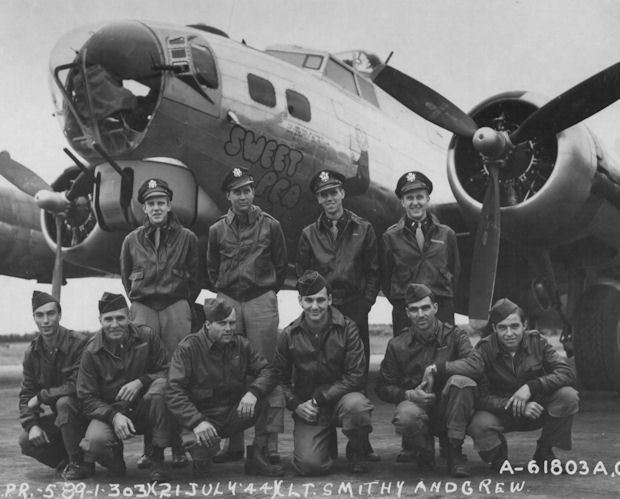
When all four engines of 1st Lt. Roman P. Charnick’s B-17 #42-97085 (358th BS) are engulfed in flames, the aircraft pulls up sharply and then explodes above Wittlich. Although other crews observe just two parachutes, only Charnick and the ball turret gunner Sgt. Fred O. Byrd perished. 2nd Lt. Leland H. Satre (on his 24th mission), 2nd Lt. Solomon Goldfield, Staff Sgt. Paul P.Carrissimo, Staff Sgt. Robert H. Neidringhaus, Sgt. Francis G.Herod and Sgt. Arthur W. Schulz were all taken prisoner. 2nd Lt. Lowell L. Rickey successfully evaded capture.
For most of the men of Tiny Angel (serial #42-102432, 427th BS), this was their 17th mission. After hitting the target their B-17 exploded over Malberg, killing pilot 1st Lt. Harry S. Cook, engineer Staff Sgt. Joseph L. Slight, and waist gunner Jess Joyce, who was flying his 28th mission. 2nd Lt. Werner G. Warmuth, 2nd Lt. Ralph E. Page, 2nd Lt. Frederick H. Mason, Staff Sgt. Forrest W. Howell, Staff Sgt. Robert F. Eaglehouse, and Sgt. John L. Smalley all parachuted from the plane and became prisoners of war. Smalley, whose leg was shot off, was repatriated to the United States after being treated by German medical staff.
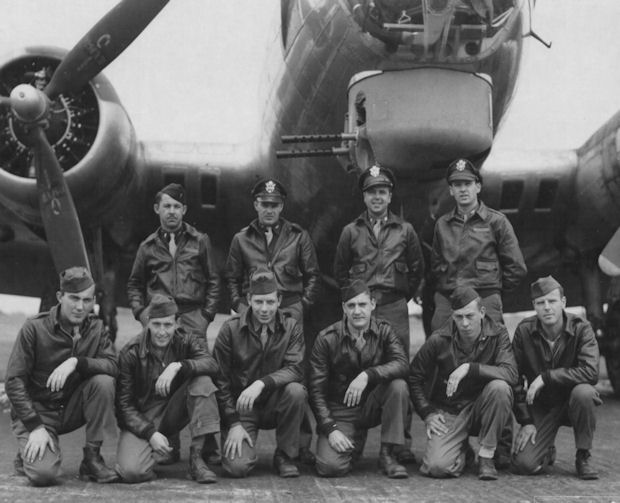
Capt. Arnold S. Litman, commanding the formation from the lead plane, had recently volunteered to stay on after his first tour of 28 missions. His 35th mission would be his last. Fearless Fosdick (#43-37838, 358th BS) went down in flames, crash-landing near Wittlich, Germany. Apart from bombardier 1st Lt. Lawrence M. Wolf, who was killed by an enemy 20mm round, Litman’s entire crew — 1st Lt. Lawrence J. Stein (pilot, 20th mission), Tech. Sgt. Fred R. Meyer, Staff Sgt. Harry R. Card, Staff Sgt. Manley E. Grissom, and Sgt. Clarence J. Williams — evaded, returning to friendly lines in September. This was the 25th mission for navigator 1st Lt. Wayne E. Krouskup, and ball turret gunner Staff Sgt. Truesdell actually escaped his captors twice before making it back.
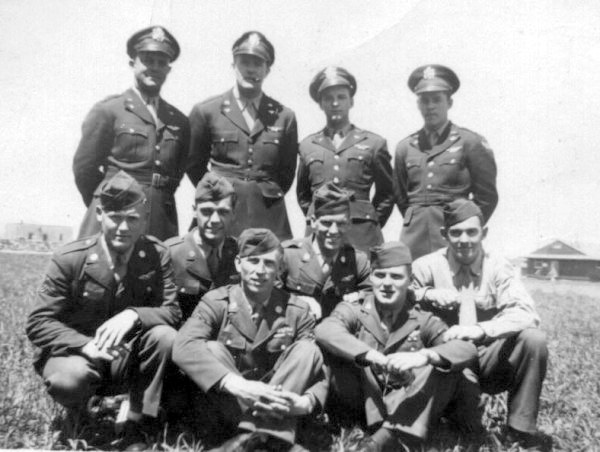
The 17th mission of 2nd Lt. Oliver B. Larson’s crew ends when a fire starts in the bomb bay and Number 3 engine of My Blonde Baby, (#44-6086, 358th BS), causing the right wing to explode. Their B-17 crashes at Seffern, killing bombardier 2nd Lt. John J. Draves when his parachute snagged on wreckage. But the rest of Larson’s crew — 2nd Lt. George B. Kersting, Staff Sgt. Robert E. O’Connor, Sgt. Charles R. Sweeney, Staff Sgt. Donald F. Mullaney, Sgt. Huber D. Holland, and Sgt. Norbert M. Philson — jumped and became prisoners of war. Navigator 2nd Lt. John M. Gard managed to briefly evade capture, but was soon back with his crew in German custody.
The crew bailed out of 2nd Lt. Alfred I. Smith’s B-17 #44-6291 (358 BS) before it crashed at Orsfield. Waist gunner Sgt. Edward Beres and tail gunner Sgt. Sam S. Bruno were killed. Smith, 2nd Lt. Emerson Jones, Jr., 2nd Lt. Stanley A. Kemp, Staff Sgt. Martin M. Harbarger, Staff Sgt. Richard A. Swanson, and Sgt. Jack D. Fischer were captured and taken prisoner. 2Lt. Robert G. King, was also held prisoner, but died shortly after his capture on 20 August 1944.
An Me-109 hit 2nd Lt. John L. Cathey’s B-17 #42-102680 (358 BS), setting the Number 3 engine and gas tank on fire. Tail gunner Sgt. Arie Moerman was killed by an enemy 20mm shell. The rest of the crew were seen bailing out before the bomber explodes just northwest of Rommersheim. Cathey, 2nd Lt. Chad W. Stephens, 2nd Lt. Charles S. Jackson, 2nd Lt. Richard T. Blomberg, Jr., Sgt. Howard B. Reichling, and Sgt. Nicholas R. Raspa were all captured and taken prisoner. Sgt. Lamar H. Whittier, and Sgt. Bert C. Nelson managed to evade capture.
Fw-190s shot down 1st Lt. Henry C. Clark’s Jigger Rooche (#42-31423, 427 BS) over Bickenforf. Clark, 2nd Lt. Gilbert P. Vesy, 2nd Lt. Ralph J. Davies, Flight Officer Earl E. Brosius, Staff Sgt. Harold P. Scott, and Staff Sgt. Frederick Roswal were killed. Sgt. Charles A. Sikora, Jr., Sgt. Cyrus S. Cruttenden and Sgt. Edwin W. Bjorn were captured and taken prisoner.
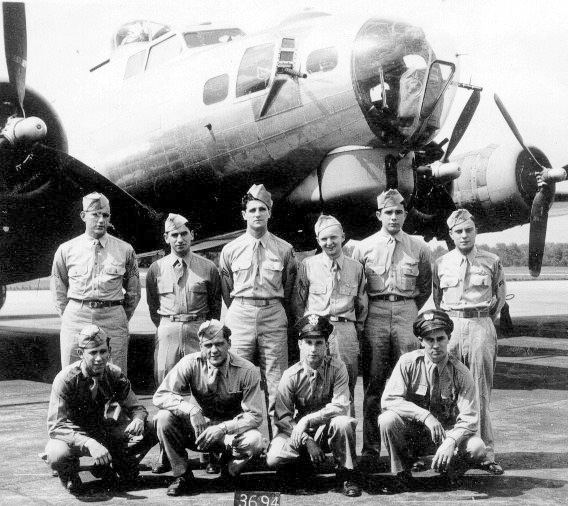
2nd Lt. Arthur L. Goss’ Bad Penny (#42-31183, 359th BS), was the first bomber targeted by enemy fighters. Bad Penny explodes in mid-air over Seinsfeld. Unfortunately for her crew, you don’t walk away from all parachute landings. Navigator 2nd Lt. Lester E. Reuss winds up hung in a tree in Preist, Germany. He tries to unbuckle himself from his harness and is assisted by two unarmed German soldiers. But before he can break free, a Nazi shoots him in the head and Reuss is savagely beat to death by two civilians armed with a club and hammer. After the war, the three Germans are found guilty of war crimes and sentenced to death by hanging. When radio operator Sgt. Patsy Rocco lands, he is captured and detained at the Indenheim police station. As Rocco is being transferred the next day, he is shot and killed by his police escort. After the war the policeman is serves two years of his life sentence in hard labor.
Sgt. James A. Earon was severely beaten once he lands. He never fully recovered from his attack, which ultimately claims his life in 1951. The capture of Goss, 2nd Lt. Harry J. Cook, Jr., 2nd Lt. Malcolm M. Fouts, Sgt. Floyd A. Sprague, Sgt. Roy M. Stevens and Sgt. Norman A. Bunney goes more smoothly, but Goss and Bunney are among several thousand Allied prisoners forced into a “death march” from Poland.
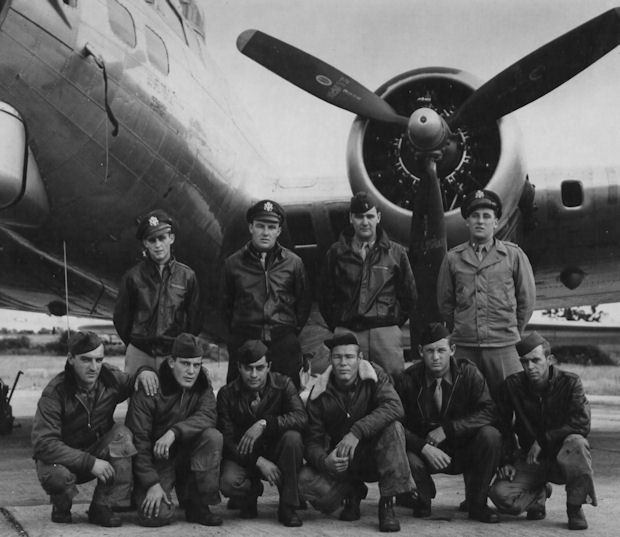
Of the 351 airmen of the 303rd Bombardment Group that left for Weisbaden that day, only 270 returned. 23 were killed. Another 48 spent the rest of the war in prison camps under horrible conditions. Ten managed to evade the Germans. Three were wounded. Though it meant everything to those that took to the skies in Flying Fortresses that day, Mission 229 had no historical significance and the story remained locked away in a box, never to be seen again (I only came across it while trying to find information on the first aerial victory by a German fighter jet). The men that made it back home may not have even spoken about it; grandchildren might only know that “grandpa fought in the war” and great-grandchildren might not even know who their great-grandpa was. The life-and-death adventures of the Hell’s Angels is all but lost to history now.
A part of the freedom we enjoy today belongs to the men that took off from RAF Molesworth that day and did not come back, and to those that survived unscathed got to roll the dice again the next day. These airmen were heroes and their story should be remembered.
Note: details on the men mentioned above will be posted in the comment section as we find them.
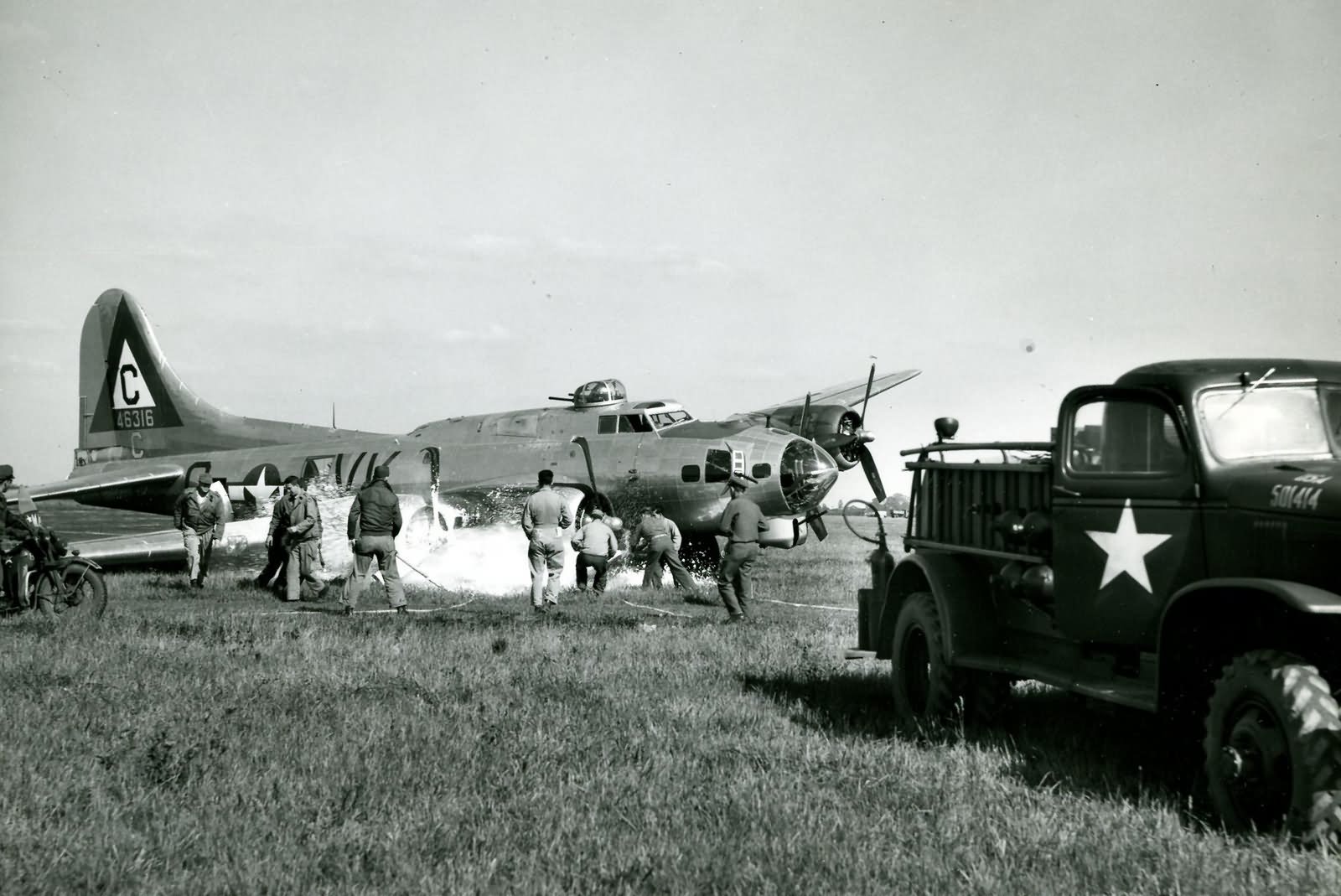
Well done Mr. Carter.
My father, Lt. Colonel Richard T. Blomberg Jr. continued to serve his country in Korea and Viet Nam. He earned the distinguished Flying Cross. He passed away May 12, 2007 is buried in Riverside National Cemetery.
Wonderful that this is available!
I miss you Grandpa. (Mullaney)
Cathy
Goss’ crew: Staff Sgt. Norman A. Bunney (Serial # 37357596) was born on his parents ranch near Aladdin, Wyo. on 20 May 1924. He attended high school in Belle Fourche, S.D. and after graduation he joined the Army Air Force. He married the daughter of John and Caroline Polzin of Belle Fourche. They moved to Casper, Wyo. where they had two daughters. Passed away 10 January 2003. Buried: Oregon Trail State Veterans Cemetery in Evansville, Wyo. Source: findagrave.com
Clark’s crew: Buried at Lorraine American Cemetery and Memorial in France are: 1st Lt. Henry C. Clark (O-753982) of Tennessee, 2nd Lt. Gilbert P. Vesy of Louisiana, 2nd Lt. Ralph J. Davies (O-716591) of Pennsylvania, and Flight Officer Earl E. Brosius of Ohio. Clark was awarded two Air Medals and the Purple Heart. Vesy left New Orleans for basic training after which the private was selected for pilot school. Vesy deployed to Europe and flew his first of 11 missions on Clark’s crew on 23 July 1944. Staff Sgt. Harold P. Scott of Kansas is buried at Newkirk Cemetery in Newkirk, Okla.. Sgt. Cyrus S. “Sid” Cruttenden (b. 6 April 1926, d. 9 August 2005, #32954280) of Evanston, Ill. earned two Purple Hearts and two Air Medals and is buried in Heritage Gardens, in Niceville, Fla.. No records are available for Sgt. Edwin W. Bjorn (36800318).